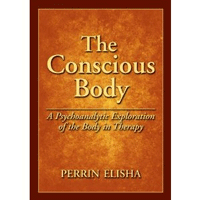“The Conscious Body: A Psychoanalytic Exploration of the Body in Therapy”

“The Conscious Body: A Psychoanalytic Exploration of the Body in Therapy”
By Perrin Elisha
American Psychological Association
Washington, D.C., 2011
Psychoanalysis ‘put on the couch’ in groundbreaking book
Reviewed by Paul Efthim, Ph.D.
The body, long neglected in psychoanalysis and psychology generally, is making a comeback. A recent uptick in publications reflects renewed interest not only in the mind-body interface but also in deeper questions about how psychotherapists conceptualize and work with somatic experience.
A brilliant new book by Perrin Elisha Ph.D., a Los Angeles psychologist, reveals how psychoanalytic theories have been largely incomplete or biased in how they deal with psychic and bodily phenomena, resulting in treatments that focus above the neck, so to speak – emphasizing mental experience in a disembodied fashion.
“The Conscious Body” puts psychoanalysis on the couch in a ground-breaking manner. The book’s central question: How do psychoanalytic theories deal with the body and what hidden assumptions or biases might be present regarding somatic concerns?
The author is well-acquainted with bodily-oriented treatment. Prior to her training as a psychologist, Elisha practiced emotionally focused bodywork and earned a degree in psychobiology. She currently practices psychotherapy and psychoanalysis, specializing in the treatment of health, body image and eating concerns.
From this unique clinical perspective straddling the mind-body divide, Elisha embarks on an intellectually ambitious, nuanced review of the philosophical assumptions embedded in the past century of psychoanalytic thought. Consistent with a psychoanalytic approach, she takes a full history, beginning with the origins of the mind-body problem in early Western philosophy and religious tradition.
The book moves on to a review of the relationship between mind and body in Freud’s theory and then to the evolution of psychoanalytic thinking on the topic through the Kleinian and British object relations schools, followed by more contemporary developments in intersubjective and relational psychoanalysis, attachment theory and neuroscience.
A concluding chapter integrates and summarizes the findings with a goal of promoting greater conscious embodiment in theory and practice.
The author observes that psychoanalysis historically has linked the body with the unconscious and the primitive, while the mind and its capacity for consciousness are associated with maturation and psychological health. Elisha notes the roots of this bias in the Judeo-Christian myth of ascension, in which life moves from primitive flesh upward toward the spiritual heavens. Psychoanalysis has conceptualized the body as a source of biological instincts (Freud’s drive theory) and as a receptacle of unconscious content (as seen in somatization and dissociation) but rarely as a source of knowledge about ourselves.
Although recent theories have generally moved beyond the Freudian “body as beast” metaphor, an implicit, unconscious valuation of psyche over soma remains evident in much contemporary thinking. This myth is unfortunate, the author argues: “If a goal of depth psychology is to speak toward the lived truths of human experience, then as psychotherapists we must ask if the language of this metapsychological myth has prevented us from learning about bodily experience. Particularly, is [this bias] … preventing a full-bodied awareness, allowing a real dynamism of lived experience fully alive in the soma?”
Further, she notes that attachment theory and cognitive neuroscience hold great promise for helping develop an alternative set of assumptions that supports an embodied practice of psychoanalysis. She cites the work of Fonagy, Target and Damasio as especially useful in developing less polarized, more dialectical conceptualizations for the relationship between mind and body.
Despite its clinical-sounding title, this book is more of a theoretically driven work. The author takes on an important but challenging task and succeeds admirably. This volume will be of interest to students of psychoanalysis and scholars in the field. Clinicians who take the plunge will be rewarded with a sophisticated discussion of a topic that receives too little attention. (For further reading from a more clinical perspective, Elisha recommends Frances Sommer Anderson’s 2008 book, “Bodies in Treatment.”) At the very least, after reading this impressive book, clincians will be less likely to invite patients to say “whatever comes to mind” and, as Elisha suggests, more “whatever comes to body.”
As psychoanalyst Susie Orbach remarked, “The body is not just a vehicle for dissociation, projection or symbolization. It is the physical manifestation of ourselves and as such demands theory and practice that help us recognize our bodies and those of our patients.” This excellent book no doubt will help move theory toward a more embodied future.
Paul Efthim, Ph.D. is a licensed psychologist in private practice in Brookline, Mass. He holds a faculty appointment at the Boston Institute for Psychotherapy and is a candidate at the Massachusetts Institute for Psychoanalysis.
Learn more about the book: The Conscious Body: A Psychoanalytic Exploration of the Body in Therapy

December 26th, 2012 at 8:43 pm Iris posted:
Iris posted:
Thank you for posting this. Having suitded counseling psychology in school, I can testify that there is certainly a political element in psychology. The program was quite cognitively behaviorally based. Gestalt psychotherapy was mentioned just a bit. I had to seek out some of my own information.In community practice, where something like 80% of treatments have to be evidenced based and officially approved as such in order for public dollars to fund them, I’ve definitely come to realize how existential psychology and/or gestalt psychology principles can be utilized through a cognitive behavioral perspective. For example, it is our thoughts about our existential meaning and/or unfinished business that can discussed in the context of officially approved evidence based practices that the government sanctions, like cognitive therapy when appropriate and relevant.
January 21st, 2013 at 11:56 am Paul Efthim posted:
Paul Efthim posted:
I agree with your comments Iris, thank you for your post. I was not aware that there is some sort of mandate for publicly-funded treatments to be evidence-based; I am curious to learn more about that. Also, there is a growing research base that supports the efficacy of a variety of treatment approaches, not just CBT.